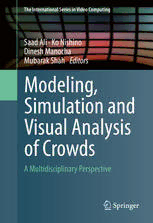Table Of ContentThe International Series in Video Computing
Saad Ali · Ko Nishino
Dinesh Manocha
Mubarak Shah Editors
Modeling,
Simulation and
Visual Analysis
of Crowds
A Multidisciplinary Perspective
The International Series in Video Computing
SeriesEditor: MubarakShah,Ph.D
UniversityofCentralFlorida
Orlando,Florida
Forfurthervolumes:
http://www.springer.com/series/6673
Saad Ali • Ko Nishino (cid:129) Dinesh Manocha
Mubarak Shah
Editors
Modeling, Simulation
and Visual Analysis
of Crowds
A Multidisciplinary Perspective
123
Editors
SaadAli KoNishino
CenterforVisionTechnologies DepartmentofComputerScience
SRIInternational DrexelUniversity
Princeton,NJ,USA Philadelphia,PA,USA
DineshManocha MubarakShah
DepartmentofComputerScience CenterforResearchinComputerVision
UniversityofNorthCarolina UniversityofCentralFlorida
ChapelHill,NC,USA Orlando,FL,USA
ISSN1571-5205
ISBN978-1-4614-8482-0 ISBN978-1-4614-8483-7(eBook)
DOI10.1007/978-1-4614-8483-7
SpringerNewYorkHeidelbergDordrechtLondon
LibraryofCongressControlNumber:2013952951
©SpringerScience+BusinessMediaNewYork2013
Thisworkissubjecttocopyright.AllrightsarereservedbythePublisher,whetherthewholeorpartof
thematerialisconcerned,specificallytherightsoftranslation,reprinting,reuseofillustrations,recitation,
broadcasting,reproductiononmicrofilmsorinanyotherphysicalway,andtransmissionorinformation
storageandretrieval,electronicadaptation,computersoftware,orbysimilarordissimilarmethodology
nowknownorhereafterdeveloped.Exemptedfromthislegalreservationarebriefexcerptsinconnection
with reviews or scholarly analysis or material supplied specifically for the purpose of being entered
and executed on a computer system, for exclusive use by the purchaser of the work. Duplication of
this publication or parts thereof is permitted only under the provisions of the Copyright Law of the
Publisher’slocation,initscurrentversion,andpermissionforusemustalwaysbeobtainedfromSpringer.
PermissionsforusemaybeobtainedthroughRightsLinkattheCopyrightClearanceCenter.Violations
areliabletoprosecutionundertherespectiveCopyrightLaw.
Theuseofgeneraldescriptivenames,registerednames,trademarks,servicemarks,etc.inthispublication
doesnotimply,evenintheabsenceofaspecificstatement,thatsuchnamesareexemptfromtherelevant
protectivelawsandregulationsandthereforefreeforgeneraluse.
While the advice and information in this book are believed to be true and accurate at the date of
publication,neithertheauthorsnortheeditorsnorthepublishercanacceptanylegalresponsibilityfor
anyerrorsoromissionsthatmaybemade.Thepublishermakesnowarranty,expressorimplied,with
respecttothematerialcontainedherein.
Printedonacid-freepaper
SpringerispartofSpringerScience+BusinessMedia(www.springer.com)
Preface
Accurate analysis and synthesis of human behavior in crowds, a large and dense
group of people with varying characteristics and goals, is a common requirement
acrossawiderangeofdomains.Ifthehumanbehavior,includingthoseofindividu-
als,smallgroupsofpeople,andeventhecrowdasawhole–canbeinterpretedand
anticipatedinarbitraryreal-worldsituations,arepertoireofimportantapplications,
manyofwhicharesocietallyimportant,canberealized:Forexample,perpetrators
disguisedinabusystreetcornerwillbeeasilyspottedandtrackedinasurveillance
videofeed;newbuildings,publicplacesandoutdoorenvironmentswillbedesigned
to optimize the space use with the dynamically changing flow of people in mind,
whileminimizingthetimeneedforevacuationwhenevernecessary;andthesocial
psychologyofpeoplecanbestudiedbasedonlarge-scale,longitudinalobservations,
andmanymore.
The goal of this book is to provide the readers a comprehensive map of the
current state of the art in distinct but related fields, mainly in computer vision,
graphics, and evacuation dynamics, towards the common goal of better analyzing
and synthesizing the pedestrian movement in dense, heterogeneous crowds. The
monograph is organized into different parts that consolidate various aspects of
research towards this common goal, namely the modeling, simulation, and visual
analysisofcrowds.Manyofthechaptersinthesepartsextendtheworksthatwere
presented at the first workshop on the same topic at International Conference on
Computer Vision, 2011, and collectively cover the diverse challenges involved in
betterunderstandingofhumancrowds.Ourhopeis,throughthisbook,thereaders
will see the common ideas and vision as well as the different challenges and
techniquesformodeling,analyzing,andsimulatingcrowds,thatwillstimulatenovel
approachestogettingusastepclosertofullygrasping“crowds.”
This book grew out of the first IEEE Workshop on Modeling, Simulation and
Visual Analysis of Large Crowds, that was held in conjunction with International
Conference of Computer Vision 2011. Therefore, first of all we would like to
acknowledge the workshop program committee who worked tirelessly for the
successoftheworkshopandauthorsthatcontributedtheirvaluablepiecesofwork.
WewouldalsoliketothankProf.JieYangandNationalScienceFoundation(NSF)
v
vi Preface
funding based on grant IIS-1142382 to provide travel support for the workshop.
We are also grateful to our host institutions (SRI International, Drexel University,
University of North Carolina and University of Central Florida) for providing a
highlystimulatingresearchenvironmentthatenablespursuitofnewresearchideas
anddiscoveries.Springerhasprovidedexcellentsupportthroughoutthepreparation
of the book, and we would like to specially thank their staff for their support
and professionalism. Many people have helped proof reading draft material and
providingcommentsandsuggestions.Wewouldliketothankallofthemfortheir
timeandvaluablecontributiontowardsimprovingthequalityofthebook.
Princeton,NJ,USA SaadAli
Philadelphia,PA,USA KoNishino
ChapelHill,NC,USA DineshManocha
Orlando,FL,USA MubarakShah
Contents
1 Modeling,SimulationandVisualAnalysisofCrowds:
AMultidisciplinaryPerspective........................................... 1
SaadAli,KoNishino,DineshManocha,andMubarakShah
PartI CrowdSimulationandBehaviorModeling
2 OnForce-BasedModelingofPedestrianDynamics .................... 23
MohcineChraibi,AndreasSchadschneider,
andArminSeyfried
3 ConnectionBetweenMicroscopicandMacroscopicModels .......... 43
Jan-FrederikPietschmann
4 AnalysisofCrowdDynamicswithLaboratoryExperiments.......... 67
MaikBoltes,JunZhang,andArminSeyfried
5 Modeling a Crowd of Groups: Multidisciplinary
and MethodologicalChallenges .......................................... 99
StefaniaBandiniandGiuseppeVizzari
6 Scalable Solutions for Simulating, Animating,
andRenderingReal-TimeCrowdsofDiverseVirtualHumans....... 123
DanielThalmann,HelenaGrillon,JonathanMaïm,
andBarbaraYersin
7 Authoring Multi-actor Behaviors in Crowds
withDiversePersonalities ................................................. 147
MubbasirKapadia,AlexanderShoulson,FundaDurupinar,
andNormanI.Badler
8 Virtual Tawaf: A Velocity-Space-Based Solution
forSimulatingHeterogeneousBehaviorinDenseCrowds............. 181
SeanCurtis,StephenJ.Guy,BasimZafar,
andDineshManocha
vii
viii Contents
PartII VisualAnalysisofCrowds
9 CrowdFlowSegmentationUsingLagrangianParticleDynamics .... 213
SaadAliandMubarakShah
10 ModelingCrowdFlowforVideoAnalysisofCrowdedScenes........ 237
KoNishinoandLouisKratz
11 Pedestrian Interaction in Tracking: The Social Force
ModelandGlobalOptimizationMethods ............................... 267
LauraLeal-TaixéandBodoRosenhahn
12 SurveillanceofCrowdedEnvironments:Modelingthe
CrowdbyItsGlobalProperties........................................... 295
AntoniB.ChanandNunoVasconcelos
13 Inferring Leadership from Group Dynamics
UsingMarkovChainMonteCarloMethods ............................ 325
AvishyY.Carmi,LyudmilaMihaylova,FrançoisSeptier,
SzeKimPang,PiniGurfil,andSimonJ.Godsill
14 CrowdCountingandProfiling:MethodologyandEvaluation........ 347
ChenChangeLoy,KeChen,ShaogangGong,andTaoXiang
15 Anomaly Detection in Crowded Scenes: A Novel
FrameworkBasedonSwarmOptimizationandSocial
ForceModeling ............................................................. 383
R.Raghavendra,M.Cristani,A.DelBue,E.Sangineto,
andV.Murino
Contributors
SaadAli CenterforVisionTechnologies,SRIInternational,201WashingtonRoad,
Princeton,NJ,USA
NormanI.Badler UniversityofPennsylvania,Philadelphia,USA
StefaniaBandini DepartmentofComputerScience,SystemsandCommunication,
ComplexSystemsandArtificialIntelligence(CSAI)ResearchCenter,Universityof
Milan–Bicocca,Milano,Italy
Maik Boltes Jülich Supercomputing Centre, Forschungszentrum Jülich GmbH,
Jülich,Germany
AvishyY.Carmi DepartmentofMechanicalandAerospaceEngineering,Nanyang
TechnologicalUniversity,Singapore
AntoniB.Chan DepartmentofComputerScience,CityUniversityofHongKong,
HongKong,China
KeChen QueenMaryUniversityofLondon,London,UK
M. Chraibi Jülich Supercomputing Centre, Forschungszentrum Jülich, Jülich,
Germany
M. Cristani Pattern Analysis and Computer Vision (PAVIS), Istituto Italiano di
Tecnologia,Genova,Italy
SeanCurtis UniversityofNorthCarolinaatChapelHill,ChapelHill,USA
A. Del Bue Pattern Analysis and Computer Vision (PAVIS), Istituto Italiano di
Tecnologia,Genova,Italy
FundaDurupinar UniversityofPennsylvania,Philadelphia,USA
Simon J. Godsill Department of Engineering, University of Cambridge,
Cambridge,UK
ShaogangGong QueenMaryUniversityofLondon,London,UK
ix

